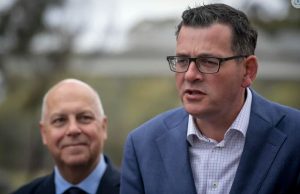Victoria’s ‘Robin Hood’ budget
Victoria’s 2023 state budget is largely aimed at paying down debt incurred during the COVID-19 pandemic with a raft of new temporary taxes while maintaining services critical to the most disadvantaged Victorians.
The state government’s ‘COVD debt levy’ targets people and businesses who it deems can most afford to pay.
But the government has refrained from wholesale cuts to programs in the health and education sectors although 4000 public sector jobs will go, saving $2.1 billion.
However funds earmarked for Multicultural Affairs Policy and Programs will rise by about $1 million to $28.3 million in 2024/25 before falling to $14.5 million in 2025/26 and $7.7 million in 2026/27.
There is continuing funding, though, for programs supporting multicultural youth including for the South Sudanese Community Support Groups, La Mana Pasifika Youth Project and the Regional Presence Project.
 Also included in the budget is $3 million in Youth Justice and $5 million through the Department of Families, Fairness and Housing to fund programs addressing early intervention and the over-representation of diverse youth in the justice system.
Also included in the budget is $3 million in Youth Justice and $5 million through the Department of Families, Fairness and Housing to fund programs addressing early intervention and the over-representation of diverse youth in the justice system.
The budget papers recognise population growth through migration as a key driver of economic growth in Victoria.
The budget includes funding for women’s health, with $63 million for 20 new health clinics.
There is also $50 million for increased access to public fertility care as well as a $23 million initiative aimed at eliminating “period poverty” which will provide free pads and tampons to women at up to 700 locations across the state.
The government will also fund thousands of extra laparoscopies to help treat endometriosis, which affects one in nine women.
Two early childhood initiatives could help mothers return to the workforce: The Our Free Kinder program will allow more children a free place in childcare and the government is also building 50 government early learning centres.
The budget also includes $77 million on providing support to victims of domestic violence.
The budget will also invest $545.5 million in the TAFE and training system.
This includes $186 million to fund expanded eligibility for subsidised training, with a focus on the Free TAFE program.
There is also $90.5 million for subsidised accredited training, including Free TAFE, and improved literacy, numeracy and digital literacy supports for students.
The budget includes $89.7 million for continued TAFE supports for Victorian students, including student support services, Jobs and Skills Centres, and coordinating regional placements.
There is also $4 million for a new apprentice mental health training program to support hard working apprentices of all trades, with a focus on young men, and members of the LGBTIQ+ and culturally diverse communities who can face extra pressure and can need targeted support.
Also, people doing an apprenticeship who rely on their vehicle for work will be provided with a waiver on their vehicle registration fee.
The budget’s COVID debt levy means people with second homes or investment properties will pay a new flat rate tax of up to $975, plus an additional levy on the value of their land from January 1, 2024.
The government will introduce a temporary levy on payroll, targeted at large businesses with national payrolls of more than $10 million.
New land tax arrangements will raise $4.7 billion by decreasing the tax-free threshold for general land tax rates for properties that are not a principal place of residence.
The budget papers say 860,000 Victorians will be affected by the measures, of which 380,000 will be first-time taxpayers.
These “temporary” measures will last for the next ten years.
About 110 private schools in Victoria will be stripped of their exemption to payroll tax next year, netting the state more than $420 million in revenue over three years.
Small business
The government is overhauling stamp duty for commercial and industrial properties to remove upfront costs and accelerate growth. It will lift the payroll tax-free threshold from $700,000 to $900,000 from July 24, and to $1 million from July 2025.
Indigenous Victorians
Almost half a billion dollars has been earmarked for ‘Aboriginal Affairs investment’. This includes funding for community-controlled organisations. As part of a $150 million boost to women’s health, an Aboriginal-led clinic will also be established.
Regions
The budget has set aside $2.8 billion over the next ten years to fix Victoria’s flood-damaged roads. This is on top of the billions already set aside in previous budgets to fix potholes and upgrade road signs. The state’s regional rail service, V/Line, has also been given $601 million for 23 new high-speed trains, which will generate 500 local manufacturing jobs.
The numbers
The budget projects a $1 billion surplus by 2025-26, and $1.2 billion by the end of the forward estimates.
But net debt will rise from about $117 billion this year to $171 billion by mid-2027.
Budget papers: Doing What Matters | Victorian Budget 23/24 | Victorian Budget












